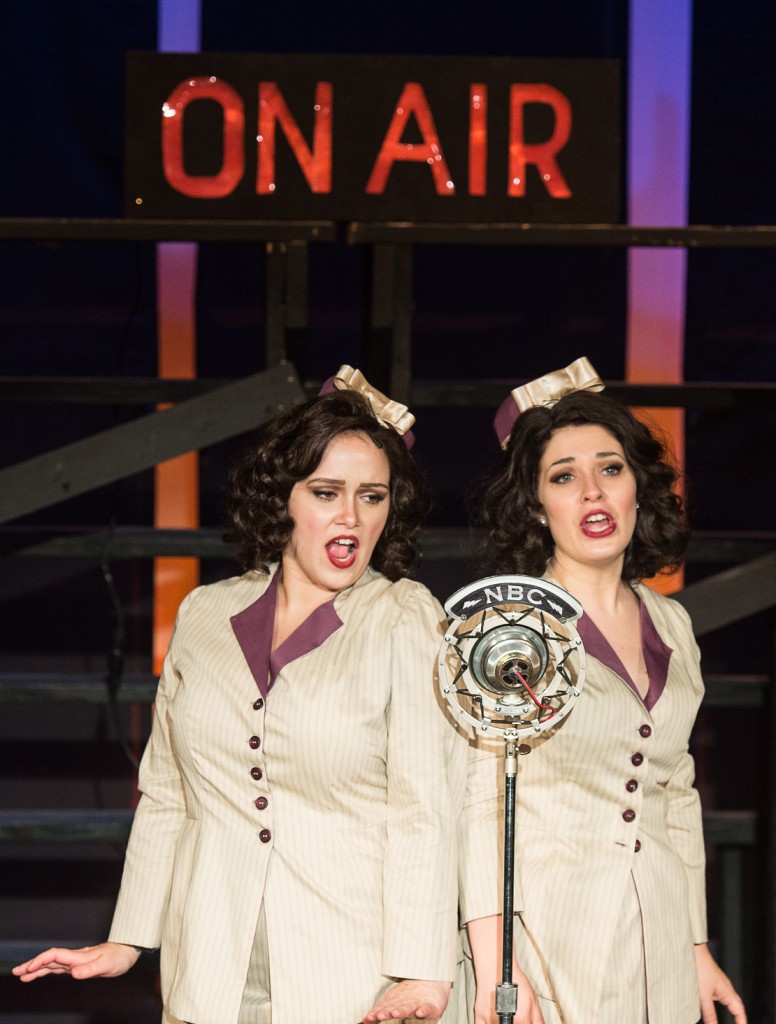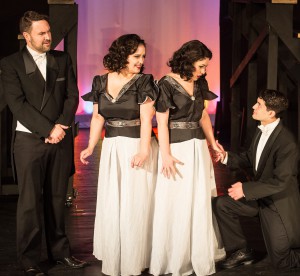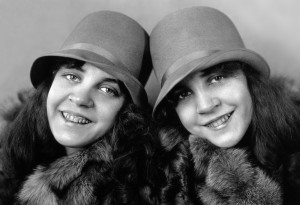With ‘Side Show,’ Stage 62 Revives a Cult Classic—and Stirs the Audience
- Like
- Digg
- Del
- Tumblr
- VKontakte
- Buffer
- Love This
- Odnoklassniki
- Meneame
- Blogger
- Amazon
- Yahoo Mail
- Gmail
- AOL
- Newsvine
- HackerNews
- Evernote
- MySpace
- Mail.ru
- Viadeo
- Line
- Comments
- Yummly
- SMS
- Viber
- Telegram
- Subscribe
- Skype
- Facebook Messenger
- Kakao
- LiveJournal
- Yammer
- Edgar
- Fintel
- Mix
- Instapaper
- Copy Link
No doubt about it. Side Show is a freaky musical. On opening night, Stage 62’s revival of this little-known play drew a standing O. But even as my theater-going buddy and I clapped along, we were glancing sideways at one another, as if to ask: What is it exactly that we’re applauding?

When Daisy Hilton (Cara Walkowiak, left) and her twin Violet (Kristin Welch) belt one for the airwaves, they’re beyond being a sideshow act; they are the main event.
Certainly one can be swept up just by the power of the musical performance. The cast members can really sing, whether they’re belting out a rousing number or crooning an eerie one, and the pit band is as sharp as a triple-bladed razor. Local fans have come to expect no less from Stage 62, perhaps our region’s strongest community theater company. In recent years the company has knocked ‘em dead with productions of Broadway standards like Sweeney Todd and Avenue Q.
This time they have taken on a not-so-standard piece. And the play’s the thing that leaves you wondering how, why, and whether or not you love it.
There is, however, one ultimately compelling reason to see Side Show (which runs through July 27). We will get to that reason by looking at what it’s all about.
The True Backstory
Side Show is based loosely on the lives of Daisy and Violet Hilton, who were Siamese twins joined at the hip. Born in 1908—to a British barmaid who soon gave them up—the Hilton sisters went on to tumultuous careers in the U.S. They worked in carnival sideshows and then broke away to star in a vaudeville revue of their own. They tap-danced with Bob Hope. They had lovers and admirers; they had crises and heartbreaks.
In 1932, the Hilton twins appeared in Tod Browning’s Freaks, one of the most controversial (and disturbing) major movies ever released by a Hollywood studio. Freaks, filmed for MGM, was set in a carnival and used real sideshow performers—some of them far more severely disfigured than the Hiltons.
Daisy and Violet outlived the carny-and-vaudeville era, eventually dying in the flu epidemic of 1969. For years, their minor part in Freaks remained their chief artistic legacy. Freaks had gained an enduring second life as a cult film, screened in art houses and analyzed in college courses and scholarly papers.
Then in 1997, the Hiltons became the subjects of a play destined to become a cult classic in its own right. Side Show made a nice initial splash on Broadway that year, but soon vanished into the theater equivalent of the art-house circuit.
Today there seems to be a surge of new interest in plays about human sideshow attractions. Bradley Cooper (Silver Linings Playbook) has been signed as the lead for an upcoming New York revival of The Elephant Man. Earlier this summer, a rewritten version of Side Show itself played to rave reviews at the Kennedy Center in Washington, D.C. Now Pittsburghers can see not the remake, but the Broadway original, as done by Stage 62.
Fame and Love, Double Lives and Deeper Meanings
“Come look at the freaks!” That’s the title line of the opening song in Side Show, sung by the ensemble in 1930s-vintage street clothes. The cast soon slips into costumes to play sideshow performers and other roles, while the line turns into a refrain echoing throughout the musical.
In this fictionalized treatment, Daisy Hilton (played by Cara Walkowiak) is the brash and brazen twin who dreams of fame. Violet (Kristin Welch) is more of a shrinking violet, the shy one who yearns for a normal life with hubby and kids. The actors portray the conjoined twins by literally staying hip-to-hip, even when they dance.
The plot revolves around their big break from sideshow life to stardom. Along with freaky colleagues such as a bearded lady, a rubber-limbed reptile man, and a sinister cannibal king, the twins have been slaving under the cruel lash of The Boss (David Cary). They are rescued by a pair of aspiring show-biz entrepreneurs, Terry (Chad Elder) and Buddy (Andrew DeBonis), who see great potential in the girls.
From there, the play’s action divides neatly into two acts. In Act 1, the twins hit it big but find that success isn’t enough. They want love, and Act 2 is the quest for love. Good candidates are close by, as their new managers grow infatuated with them—Terry with Daisy, Buddy with Violet—plus, they’ve got a backstage assistant, Jake (Korey White), who loves both twins. Complications ensue.
Likewise, the allure of Side Show derives equally from two sources. First, the big musical numbers, of which many stand out. The twins are staggeringly sexy in their vaudeville debut song, “We Share Everything” (which of course is a double-entendre). A song-and-acting sequence in the Tunnel of Love at a state fair is dazzling.
And the wrap-up numbers for the two acts—“Who Will Love Me As I Am?” in Act 1, and “I Will Never Leave You” in Act 2—both feature the twins singing together, with the ensemble coming forward to join the choruses at the end. The effect is wonderful. We have two women singing out emotions that are then magnified by the voice of the masses. It’s like: Take us back to the radical 1930s, yeah!
The second source of Side Show’s allure is the nature of the complications that ensue. The twins after all are not normal; they are individuals physically fused. Early in the play, this predicament is used mainly for some rather predictable humor. (In one scene, annoying little tensions between the two come to the surface. Daisy trills “Leave me alone,” to which Violet sings “Now, how would I do that?”)

Terry (Chad Elder, left) watches Buddy (Andrew DeBonis) court his favorite twin, knowing that everybody here has gotten him/herself into a double pickle love-wise.
But as the plot thickens, the humor takes a darker tone. The tensions deepen, and you gradually find that you’re not just watching a musical story about two girls with a rare affliction. You are watching one that embodies predicaments we all face and aspirations we all have.
Take the quest for love. A man who loves one of the twins can’t marry (or even “make love to”) only that one; the other is part of the package. Conversely if either twin loves a man, she’ll never have him all to herself. And any of us are liable to confront the same issues, as follows:
If you marry someone, you may get the “side” of the person that attracts you, but you may also get another side you hadn’t bargained for. Similarly, it’s fruitless to hope that someone else can “belong” to you, or you to that person. We all have other attachments.
Hmm. One freaky thing about this play is that it’s both a freak show and, to borrow a line from the Talking Heads, a show about People Like Us. Not to mention the wilder aspects. At times, for example, it is flat-out awesome to watch these double-women doing everything together. A viewer may think: Hey. Instead of being a divided self, what if I were doubled? …
The Ultimate Reason
Side Show isn’t perfect. It is a long musical—two and a half hours, with intermission—and it doesn’t gather a full head of steam until about halfway through Act 1. It’s written opera-style, with nearly all lines sung rather than spoken (think Les Miz), and this interferes with the ability to develop some of the action more naturally. Every line is not golden nor every scene a stirring revelation.
Yet Side Show is moving, and ultimately worth seeing, for a reason that’s close to the reason people went to see sideshow acts like the Hilton sisters years ago. Most of us just don’t encounter this sort of thing every day. It’s a departure that leaps out at you—in more senses than merely as an “eww, look at that” kind of oddity.
Philosophers and cultural critics have written at length (and sometimes with wisdom) about the effects that highly non-normal people have upon us. Elizabeth Grosz, a professor at Duke, wrote that they “imperil the very definitions we rely on to classify humans, identities and sexes,” which in turn upsets “our most fundamental categories of self-definition.”
Who are we, and what are we, anyway? To think along such lines is at once fascinating and frightening.
And, by going to Side Show, you can take this mental journey while skipping the uglier aspects of a real sideshow act. The play “exploits” Daisy and Violet Hilton but not in the same way. You’re getting a fictional story, which, despite the many made-up parts, tries to present them as they might wish to be remembered—maybe very much as they actually were.
Closing Credits and Ticket Info
Side Show, in the original Broadway version by Bill Russell, with music by Henry Krieger, is directed for Stage 62 by Rob James. The whole cast performs admirably as does the orchestra, directed by Stephen Baldzani.
The play runs Thursday-Sunday through July 27 in the Music Hall of the Andrew Carnegie Free Library at 300 Beechwood Ave., Carnegie. (That’s in Carnegie, not Oakland!) For show times and tickets, visit Stage 62 online or call 412-429-6262.
Cast photos by Friedman Wagner-Dobler, Image 42, courtesy Stage 62.
Mike Vargo is a freelance writer and editor based in Pittsburgh.
Share on Social Media
- Like
- Digg
- Del
- Tumblr
- VKontakte
- Buffer
- Love This
- Odnoklassniki
- Meneame
- Blogger
- Amazon
- Yahoo Mail
- Gmail
- AOL
- Newsvine
- HackerNews
- Evernote
- MySpace
- Mail.ru
- Viadeo
- Line
- Comments
- Yummly
- SMS
- Viber
- Telegram
- Subscribe
- Skype
- Facebook Messenger
- Kakao
- LiveJournal
- Yammer
- Edgar
- Fintel
- Mix
- Instapaper
- Copy Link
Follow Entertainment Central
Sign up for the EC Newsletter
Latest Stories









